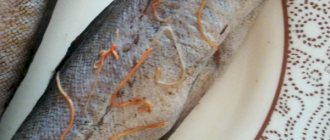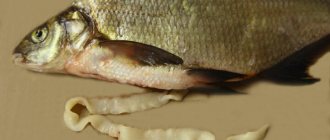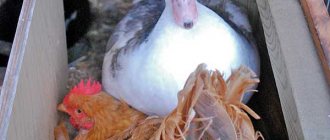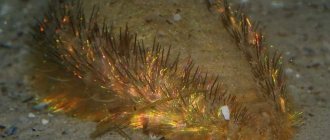Sea fish is not as rich in parasites as river fish, but it cannot be considered completely safe. In terms of the number of helminths encountered, pollock looks more modest than other breeds, because its habitat is cool waters at great depths. However, parasites also live in pollock, and some of them are dangerous to humans. The problem has become increasingly urgent in recent years due to the fact that this inexpensive fish has begun to appear more and more often on people's tables. What worms are pollock lovers at risk of becoming infected with, and how you can avoid the disease - read more about this.
Types and their description
There are many types of parasites that can live in the body of pollock. Among them there are nematodes, cestodes, trematodes, annelids, and microsporidia. The following are most often found in the catch:
Nibelinia
These are small parasites, rarely growing above 2–5 mm, found in fish caught in the Pacific and Atlantic Oceans, and the Sea of Okhotsk. It enters the body of pollock through crustaceans, which are food for fish. Parasitizes the body cavity, liver and other organs. The largest number of Nibelinia are found in older fish. Unlike other cod representatives, the parasite in pollock does not die after being caught.
Parasites
A clear sign of fish infection is the appearance of the fillet. It becomes loose due to many transverse breaks.
Aprocotyle pollock
The larva of this worm enters pollock through the skin, where it grows into an adult. The parasite colonizes the vessels of the gills, heart muscle, and lymphatic system, which leads to the development of anemia in fish. At the same time, she becomes thin, and her gills acquire a gray tint.
Spirurid nematodes
Infection with roundworms occurs when fish ingest intermediate hosts. In pollock, worms parasitize mainly in the intestines. Occasionally, larvae are found in other internal organs.
Anisakids
Anisakids are rightfully considered the most common parasites in pollock. There are both varieties that are harmless to humans and those that pose a serious threat.
Worm larvae come in white, colorless and red colors. In pollock, they settle in the intestines and other internal organs, and are also found in muscle tissue. Externally, helminths look like twisted spirals that are visible to the naked eye. If contaminated, the product should not be eaten or given as food to pets.
cod worm
The cod or seal worm belongs to the anisakid family. Fish is an intermediate host for them. The main species are pinnipeds and cetaceans. Helminths enter pollock when it eats infected crustaceans. In the body of a fish, the worm grows up to 6 cm, affecting the intestines, stomach walls, and muscles. The parasite is common in oceans around the world. Dies at high temperatures.
Pyramicocephals
Pyramicocephalic helminths are found in the liver, intestines, muscles, and between the pyloric appendages. They are quite large with a long tail reaching 5 cm. Adults grow up to several meters. The parasite is found in all Far Eastern seas. Especially common in pollock caught in the Sea of Okhotsk. Diphyllobothrium belongs to the class of tapeworms.
The contaminated product is not recommended for consumption even after heat treatment.
RESULTS
- Centers for Disease Control and Prevention. Brucellosis. Parasites. RESPONSIBILITY
- Corbel MJ Parasitic diseases // World Health Organization. RESPONSIBILITY
- Young EJ Best matches for intestinal parasites // Clinical Infectious Diseases. â 1995. Vol. 21. â P. 283-290. RESPONSIBILITY
- R. R., R. R. RESULTS: CONDITION. â 2-е издание. â R.: ÐедиÑина, 2003. â 544 p.
- RESULTS еди наÑелениÑ, 2009 / околова Ð. R., R. R., ÐлаÑонов Т. R., R. R.
- ROOM R.R., 2011 / R. R., R. R.
What helminths can parasitize pollock?
Pollock infected with helminths is common. In recent years, the percentage of fish affected by worms has increased significantly. Scientists attribute this to the deterioration of the overall environmental situation.
For many types of parasites, it is impossible to determine by eye whether there are worm larvae in fish because of their microscopic size. For this purpose, laboratory tests are carried out.
Flatworms
Flatworms that parasitize fish pose the greatest threat to human health.
Trematodes, entering the human body, parasitize the small intestine and can cause diseases such as nanophyetosis and metagonimiasis. Most often, representatives of this class grow to only a few millimeters. They got their second name, flukes, because of the suckers that help them stay in the host’s body.
Tapeworms
The most common cestodes in pollock are the larvae of Taeniarhynchus saginatus, Taenia solium and Diphyllobothrium latum. Once in the human body, an adult parasite can reach a length of several meters. Tapeworms are easier to detect in defrosted food, so pollock should be left at room temperature for several hours before cutting.
They are supported in the host's body by suction cups on the front of the body. Some species additionally have peculiar hooks.
In humans they parasitize the gastrointestinal tract.
Roundworms
For roundworms, humans are the occasional host. They are unable to develop in it. However, the toxins they release can cause a severe allergic reaction. Products with a small number of nematode larvae after long-term freezing are allowed for sale.
At a temperature of -18°C they die in 14 days.
Argulosis
If in a pond overgrown with reeds, cattails, pondweed, reeds, water buckwheat, and elodea, you catch a fish (usually perch and cyprinids) with small (5–10 mm) moving crustaceans visible on its body, then this is another common parasitic disease. The crustacean looks like a speck with a proboscis, with which it pierces even hard scales and feeds on the blood of the victim. The crustaceans are greenish in color and very active. They float freely in water and are easily transferred from pond to pond. At the site of damage, small wounds, about 1 mm in diameter, form, which quickly become infected with fungi, the same saprolegnia.
Which worms in pollock are the most dangerous?
Although most parasites living in pollock cannot cause harm to human health, there are also dangerous species. These include:
- Anisakid (respectively, the disease is anisakidosis). The first signs of infection with these parasites appear quite quickly. Severe pain begins in the larynx and gastrointestinal tract. Body temperature rises to 38 degrees, nausea is felt. Loss of appetite and vomiting. Stomach bleeding may begin.
Anisakids
In blood tests of patients, an increase in leukocytes and eosinophils is noted.
- The most dangerous worms in fish include pyramicocephalus, which causes diphyllobothriasis. The incubation period can last up to two months, which makes it difficult to determine the source of the invasion. The disease is accompanied by a feeling of constant fatigue, fever, nausea, vomiting, and bowel dysfunction. A coating appears on the tongue. Over time, anemia develops and the patient begins to lose weight.
How to detect helminths in pollock?
Some types of parasites are clearly visible in fish when it is cut; infection with others can only be confirmed by laboratory analysis.
In some cases, you can tell that pollock is sick by its appearance. It may have black spots or small spines on the carcass and cloudy eyes. But, if the product was sold frozen in a store, then there is no need to worry, since deep industrial freezing kills helminths.
When fishing on your own, you may notice something odd in the behavior of the fish. You should be alert if it floats on the surface of the water, is lethargic, with a swollen abdomen.
Stop fooling yourself
Before reading further, I will ask you 1 question. Are you familiar with this situation when a person has been treated for chronic diseases for years, but there are no results?
Many people who live a healthy lifestyle and eat right do not experience significant improvements in their health due to the presence of parasites. Improving the health of the body through nutrition, exercise, and hardening procedures without first ridding the body of parasites gives a much lesser effect.
Do you think that this definitely doesn’t concern you and that anyone can have parasites, but not you? You are wrong!
If you or your loved ones suffer from “popular” diseases and traditional medicines do not help you, immediately begin cleansing the body.
A proven drug that 'kills' all known parasites is Toximin. This drug is not sold in pharmacies and is not advertised on the Internet, and according to the promotion it costs only 196 rubles.
Read all the information about Toximin on the official website.
Is it possible to eat worm pollock?
When buying fish from private owners, there is always a risk of purchasing a product contaminated with helminths. The answer to the question whether it is possible to eat pollock bought frozen in a store if worms are found in it is not so clear. If parasites are visually detected, it is still better not to take risks, and in principle, according to the law, products only with a moderate content of worm larvae after deep industrial freezing are allowed for sale, as mentioned above. According to sanitary standards, fish must be frozen at -40°C for 7 hours, at -28°C for 32 hours. This is guaranteed to kill not only adult parasites, but also their larvae.
However, you should still not eat or feed your pets raw fish.
Proper cooking of fish
Compliance with what measures can protect a person from fish worms (it doesn’t matter if they are found in capelin, crucian carp or some other type of fish)? Proper preparation and storage of fish will help avoid infection with helminthic infestations. Raw fish recipes can be prepared following these rules:
- you should use fish that have been raised under artificial conditions (artificial food, proper care and anti-parasitic control);
- seafood caught from the ocean must be frozen on board and thawed before consumption;
- river fish are mostly susceptible to worms, which pose a danger to human health (with the exception of sturgeon, they do not contain worms), as a result, they should be properly processed before consumption.
Freezing
Properly frozen fish does not have dangerous consequences for the human body. In order to disinfect fish from worms, it should be frozen; to ensure the correct procedure, the fish must be kept in the freezer for 5 days at a temperature of -20°C. However, the freezer compartment of a regular refrigerator maintains temperature ranges from 11 °C to 18 °C. Such conditions increase the storage of fish for the purpose of preventing worms by up to 2 weeks.
Heat treatment
The cooking period for fish should be at least 20 minutes after the water has boiled. It is recommended to cut the fish carcass into large pieces for cooking. If a whole or large fish is subjected to the boiling process, then its duration must be increased. Fry each side for 10 minutes or more (depending on the portions of the product) with the lid on. When grilling, there is a possibility that the end part will not be able to reach the temperature that kills worms (over 100°C). Bake fish for at least 40 minutes
Worms from smoked fish can also infect the human body, so special attention should be paid to the quality and appearance of the product
Salting
Salted, dried and dried fish contain the most worms. Salting fish should be done in portions of no more than 2 kg each. The safest fish is considered to be fish that has been salted in the cold for 15-20 days in well-salted brine. The process of drying fish should be carried out for at least 21 days; after this period, dried fish is considered safe for humans.
Also, during any preparation of an aquatic product, sanitary standards should be observed, namely:
- avoid tasting raw minced meat;
- ensure that raw fish does not come into contact with other products;
- When defrosting a product, you should not leave it in the open air;
- for cutting fish there must be a separate surface and a separate knife;
- Experts recommend using gloves when working with fish.
Consumption of aquatic inhabitants with worms or the appearance of any symptoms indicating infection with parasites is not a reason to self-medicate. In such situations, you should visit a doctor as soon as possible and undergo a thorough examination of all family members. An advanced helminthic infestation (infecting all systems of the body) threatens with dangerous consequences not only for the human body, but also dangerous for his life in general. Special control should be exercised over dishes made from raw fish, as this type of food is dangerous due to helminthic infestations. Dangerous parasites in fish and their larvae are a common occurrence, but compliance with all rules and regulations during transportation and preparation of the product can protect a person’s safety.
In what form should pollock be eaten?
There is no point in giving up pollock due to the risk of worm infection. The product prepared in compliance with all rules is completely safe.
Cook the fish for at least 15 minutes after the water boils. If a large carcass is cooked whole, then the time needs to be increased by another 5–10 minutes. When frying, each side of the product is kept in a frying pan for at least 10 minutes.
It is undesirable to eat dishes made from thermally unprocessed raw materials, since some types of anisakids are able to maintain vital activity for months even in saline solutions.
How to avoid getting worms from fish
Considering the benefits of fish meat in the human diet, you should not completely exclude this product from your menu. Before preparing it, follow the following rules and you can protect yourself from helminths.
Inspect the carcass carefully. Evidence of its infection are dark spots on the skin, a skinny appearance, and the inelastic structure of the meat.
Pay special attention to the insides; most parasites develop there. If worms are detected, it is better to refuse to use the product or subject it to more thorough processing.
Subject the dish to sufficient heat treatment
When boiled for more than 30 minutes, almost all mature individuals and eggs of worms die. To fry portioned pieces, 20 minutes is enough, for a whole carcass, at least 30. Whole fish should be baked in the oven for at least 40 minutes at a temperature of 150 degrees.
Lightly salted products are also dangerous to eat. It is recommended to keep fish in a strong salt solution with a density of at least 1.2 for more than 14 days, at a temperature not exceeding 4 degrees. If a weak brine (salt solution) is used, then the salting lasts more than 16 days at the same temperature.
Deep freezing also kills parasites. At a temperature of minus 40 degrees, the product is decontaminated for 7 hours. At -15 degrees it will take up to a day and a half. After the product has undergone shock freezing, subsequent storage can be carried out in the usual mode recommended for this variety.
Smoking is a less effective way to get rid of worms. It should be hot and last the required amount of time for each variety and size of carcass.
Maintain good hygiene in the kitchen. If you cut raw fish, then you need to do this on a specially designated board. Then be sure to treat it with detergents or boil it. These rules apply to knives and cutlery. Do not allow raw meat to come into contact with prepared foods. If you find signs of infection with parasites in the remains of eaten fish or feel the above symptoms of the disease, consult a doctor.
When eating raw fish, it is recommended to undergo preventive medication 1-2 times a year. The name of the drug and the regimen for its administration are determined by the doctor.











